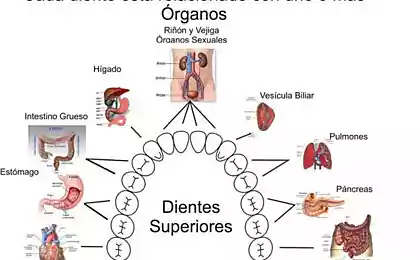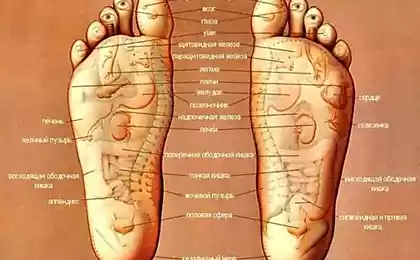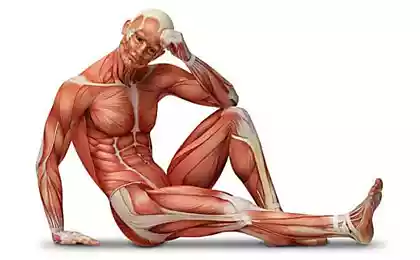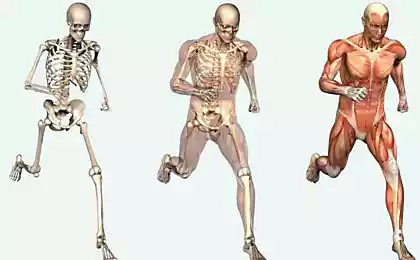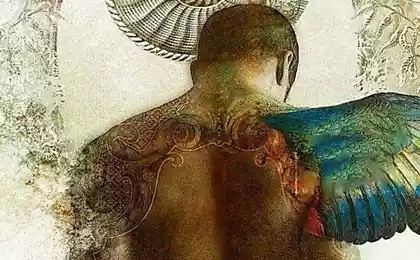490
Myofascial meridians
Thomas Myers in his book "Anatomical trains" (Thomas W. Mayers. AnatomyTrains, 2001, 2009) describes myofascial meridians (lines) that are located symmetrically on both halves of the human body, connecting its various parts into a unified whole.
For example, the superficial back line when a bent knee is functioning as a continuous line of myofascial relationships, encompassing the entire rear surface of the body from the sole of the foot to the fascia down to the zygomatic arches.
Eighty six million six hundred sixty four thousand sixty five
Myofascial structures join the fascia of the skull from the brow, across the occiput, sacral-lumbar fascia/muscle, straightening the spine and then the sacrum, the Sacro-bugrovoy ligament, ischial tuberosity, muscles of the knee joint, the calf muscles to the plantar fascia and the phalanges of the toes (Fig.1). Superficial back line involved in the retention body in a vertical position and prevents the body's desire to curl in flexion.
Superficial front line unites the entire front surface of the body from the rear feet to the side of the skull in two areas: from the toes to pelvis and pelvis to head, which, when straightened, the hip joint functions as a solid line of interactive myofascia (Fig. 2).
Her motor function is flexion of the torso and thigh, straightening the knee joint, extension of the foot, flexion of the spine in the cervical region. The tension of the muscles and fascia the superficial front line causes a compensatory stretching the superficial back line, restricts the movement of the ribs, lock the breath in the expiratory phase.
Fifteen million eight hundred twenty nine thousand seven hundred one
Spiral myofascial line one coil wrapped around the body, connecting one part of the skull on the opposite shoulder and leg on the same side (Fig. 3). She is involved in a spiral and rotational movements of the body.
Thirty one million two hundred ninety two thousand four hundred eight
The lateral line extends on both sides of the body from the medial and lateral mid point of the foot on the outer side of the tibia, and ascends on the lateral side of the tibia and femur, passing a "double zigzag" along the torso to the skull around the ear (Fig 4).
Forty three million three hundred sixty eight thousand six hundred ninety two
A function of the lateral line is to balance the front and rear, right and left parts of the body in an upright position. It also mediates preparedata efforts between the other surface lines-superficial front line, superficial back line, lines of the hands and spiral myofascial line.
Myofascial arm line deviated from the axial skeleton to the four "sides" of the arms and hands: the thumb, little finger, palm and dorsum of the hand (Fig.5). Line the hands are involved in the implementation of all movements of the joints of the hands. In addition, they are connected with other lines, in particular the lateral and spiral.
Eighty eight million nine hundred six thousand five hundred eighty eight
In addition to the surface lines (superficial back and front lines), there are deep lines that also carry out their unifying and stabilizing function.
Execution of movements involving segmental, associative muscles and muscles that are included in myofascial lines, has a corrective effect on the status and function of the cardiovascular system by reflex (motor-visceral) effects.
Elixir "7 cups" —an amazing rejuvenating and cleansing of the whole body!
Psychosomatics hypertension
Therefore, programs of physical therapy patients with cardiovascular diseases or preventive exercise it is advisable to use exercises that involve segmental and associative muscles and myofascial linkages.published
"Anatomy Trains" Thomas W. Myers, 2009
P. S. And remember, only by changing their consumption — together we change the world! ©
Source: www.facebook.com/metavitonica/posts/1757571501121102
For example, the superficial back line when a bent knee is functioning as a continuous line of myofascial relationships, encompassing the entire rear surface of the body from the sole of the foot to the fascia down to the zygomatic arches.
Eighty six million six hundred sixty four thousand sixty five
Myofascial structures join the fascia of the skull from the brow, across the occiput, sacral-lumbar fascia/muscle, straightening the spine and then the sacrum, the Sacro-bugrovoy ligament, ischial tuberosity, muscles of the knee joint, the calf muscles to the plantar fascia and the phalanges of the toes (Fig.1). Superficial back line involved in the retention body in a vertical position and prevents the body's desire to curl in flexion.
Superficial front line unites the entire front surface of the body from the rear feet to the side of the skull in two areas: from the toes to pelvis and pelvis to head, which, when straightened, the hip joint functions as a solid line of interactive myofascia (Fig. 2).
Her motor function is flexion of the torso and thigh, straightening the knee joint, extension of the foot, flexion of the spine in the cervical region. The tension of the muscles and fascia the superficial front line causes a compensatory stretching the superficial back line, restricts the movement of the ribs, lock the breath in the expiratory phase.
Fifteen million eight hundred twenty nine thousand seven hundred one
Spiral myofascial line one coil wrapped around the body, connecting one part of the skull on the opposite shoulder and leg on the same side (Fig. 3). She is involved in a spiral and rotational movements of the body.
Thirty one million two hundred ninety two thousand four hundred eight
The lateral line extends on both sides of the body from the medial and lateral mid point of the foot on the outer side of the tibia, and ascends on the lateral side of the tibia and femur, passing a "double zigzag" along the torso to the skull around the ear (Fig 4).
Forty three million three hundred sixty eight thousand six hundred ninety two
A function of the lateral line is to balance the front and rear, right and left parts of the body in an upright position. It also mediates preparedata efforts between the other surface lines-superficial front line, superficial back line, lines of the hands and spiral myofascial line.
Myofascial arm line deviated from the axial skeleton to the four "sides" of the arms and hands: the thumb, little finger, palm and dorsum of the hand (Fig.5). Line the hands are involved in the implementation of all movements of the joints of the hands. In addition, they are connected with other lines, in particular the lateral and spiral.
Eighty eight million nine hundred six thousand five hundred eighty eight
In addition to the surface lines (superficial back and front lines), there are deep lines that also carry out their unifying and stabilizing function.
Execution of movements involving segmental, associative muscles and muscles that are included in myofascial lines, has a corrective effect on the status and function of the cardiovascular system by reflex (motor-visceral) effects.
Elixir "7 cups" —an amazing rejuvenating and cleansing of the whole body!
Psychosomatics hypertension
Therefore, programs of physical therapy patients with cardiovascular diseases or preventive exercise it is advisable to use exercises that involve segmental and associative muscles and myofascial linkages.published
"Anatomy Trains" Thomas W. Myers, 2009
P. S. And remember, only by changing their consumption — together we change the world! ©
Source: www.facebook.com/metavitonica/posts/1757571501121102

